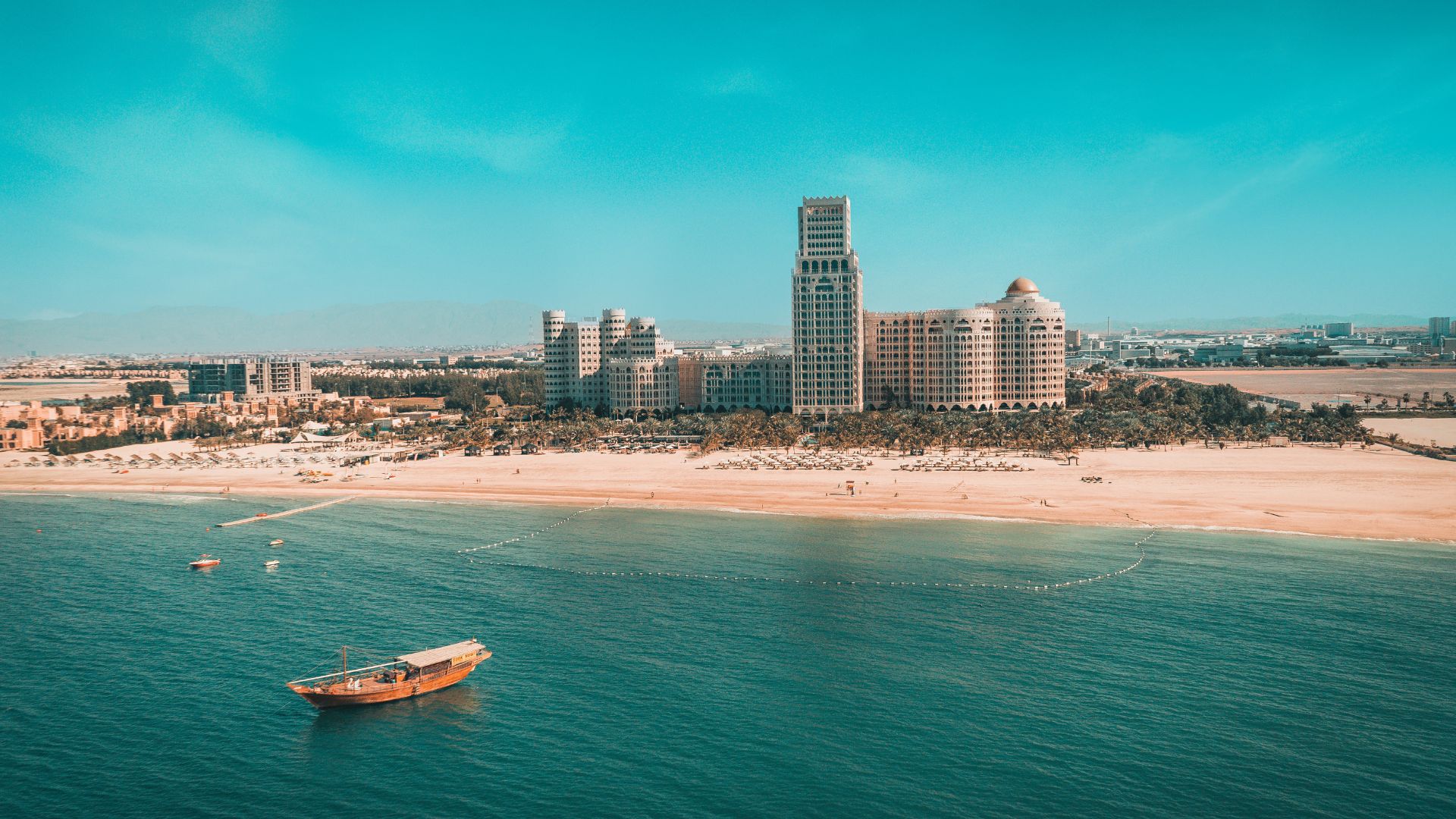
The waning of European power in the Gulf, along with the decline of Omani and Persian states following the Omani-Persian wars in 1720, contributed to the rise of the Qawasim. They set up their bases at Julfar or Ras Al Khaimah and Sharjah and also controlled other ports of strategic importance along the Arabian coast, including Umm Al Quwain, Al Hamra, Al Rams, Buhabil, Ajman, Shanas, Khorfakkan and Khor Kalba. Their influence also extended to ports of Lengeh, Luft, Kunk and Ras Al Heti on the Persian side of the Gulf. They controlled the Gulf, which meant that they played a crucial part in dictating matters relating to regional politics and other affairs during the eighteenth century.
The Origins Of The Qawasim
Tradition has it that a leader named Sheikh Qasim settled on the coast of Ras Al Khaimah many centuries ago. Seeking a commanding winter base for his tribe, one day he came upon a raised point of land within sight of the Hajar Mountains. Content with what he had found, he and his followers pitched their tents and would return to the same location every winter. Over time, others joined them, until a large settlement emerged and became known as Ras Al Khaimah (the ‘top of the tent’ in English). It is a myth, of course, but one that is deeply embedded in the history of the Qawasim.
Whatever the origin of this story, it predates the modern era. Charles Rathbone Low, a British officer in the Indian Navy, mentions it in The Land of the Sun: Sketches of Travel, with Memoranda, Historical and Geographical, of Places of Interest in the East, and it appears in other documents too. Published by Hodder & Stoughton in 1870, Low’s account stated that: “According to Lieutenant Wellsted of the Indian Navy, the name of Jowassami was derived from Johasmi a Mohammedan saint, who first pitched his tent on the promontory where was built their chief port, called hence Ras-el-Khymah, or Cape Tent.” The original source of this information, Lieutenant James Raymond Wellsted, whose Travels in Arabia was published in London in 1838, said that the leader had “resided on a low tongue of land, and the tents of his followers, which were pitched around, gave the name of Rás el Khaïmah, or ‘Cape of Tents,’ to the promontory on which a town bearing the same designation was subsequently erected.”
In reality, the exact origins of the Qawasim are unknown. One theory holds that the ancestors of the Qawasim migrated from deep within the Arabian peninsula, possibly following a split among a tribal grouping known as the Nizar. Certainly, the descendants of the non-Azd tribes of south-east Arabia were often referred to as ‘Nizar’ by early Arab chroniclers. This view appears to have been maintained in some form up until the arrival of the British. In the early nineteenth century, the British civil servant Francis Warden, who was chief secretary to the government in Bombay, briefly discussed the origins of the Qawasim in an Historical sketch of the Joasmee [Qawasim] tribe of Arabs, from the year 1747 to the year 1819. Published posthumously by the Bombay Education Society Press in 1856, Warden noted that: “The Joasmees are a race of Arabs descended from the inhabitants of Nujd [Najd in Saudi Arabia], and named Beni Nasir, as being on the left-hand side of the Caaba; and called also Beni Gafree. They have possessed the principality of Seer, in Oman, and been an independent tribe, from the earliest ages.”
An alternative theory – that the Qawasim descend from the Huwala, a group of Arab seafaring tribes who inhabited the shores of the Persian coast – has also proven popular throughout history. Although it is not known when they may have first settled there, their migration could have occurred following the Islamic conquest of Iran and the defeat of the Sasanian Empire in the seventh century. When the German cartographer and explorer Carsten Niebuhr wrote of Ras Al Khaimah in the late eighteenth century, he referred to the ‘Schiech of Seer’ as being ‘of the tribe of Houle’. The Dutch East India Company’s agent on the island of Kharg, Baron Tiddo Frederik van Kniphausen, also noted that Ras Al Khaimah was “inhabited by the tribe of Huwala called Quassum”. Hamid ibn Muhammad ibn Ruzayq, the author of A History of the Imams and Seyyids of Oman, also referred to the ‘elHawalah’ of Julfar. So, too, did the British army officer and political agent Samuel Barrett Miles, whose The Countries and Tribes of the Persian Gulf was published in 1919. Miles noted that during the eighteenth century “the forbears of the Joasmees, the Hawala tribe, had given much trouble to Nadir Shah”.
In truth, the Qawasim are most probably of local origin, although this is impossible to prove with absolute certainty. It is not clear when the Qawasim originally settled in Ras Al Khaimah, however the first recorded mention of them dates as far back as 1624. According to Portuguese sources, the fort at Kalba was ruled by a leader known as ‘Casmi’ (Al Qasimi), who had captured the stronghold following a revolt against Portuguese rule a year or two earlier. Although it was eventually recaptured by Gaspar Leite on the orders of Admiral Ruy Freire da Andrada, the power and influence of the Qawasim must have been well established at that time. In fact, the ‘Casmi’ leader may have been Sheikh Kayed bin Hamoud Al Adwani Al Qasimi, who is believed to have built the original Al Adwani Tower at Khor Fakkan.
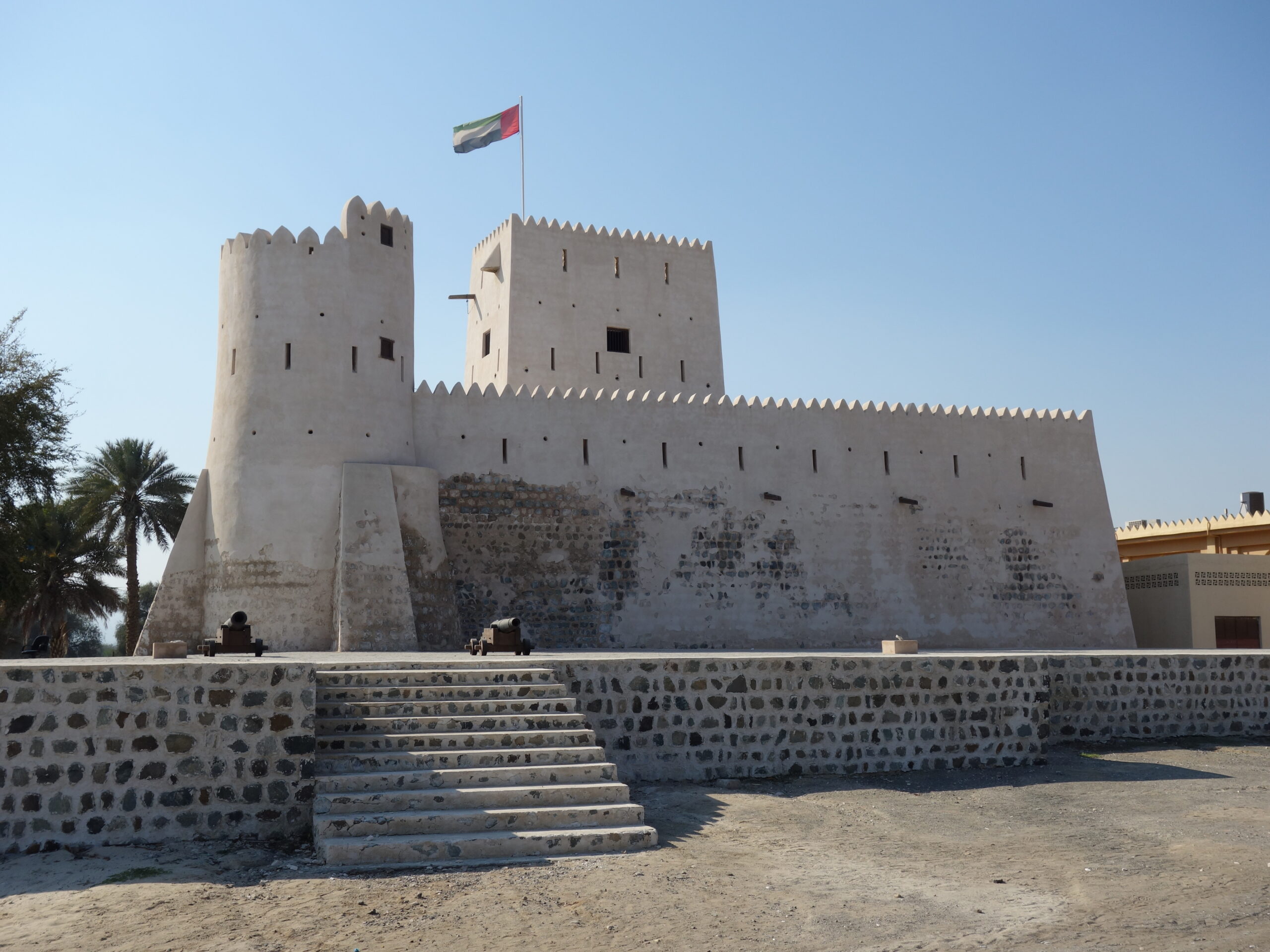
The restored Kalba Fort. The original fort fort stands on the site of an original fortification captured by the Portuguese.
The Qawasim are mentioned again in 1650, this time in relation to a peace treaty between the Portuguese and the Omanis. The agreement, although never executed, was signed by Portuguese envoys and two Omani diplomats, one of whom was referred to as ‘Sefo ben Aly ben Sali el-Casmi’ (Sayf bin Ali bin Salih Al Qasimi). The peace treaty stated that only Muscat and Khasab would remain in Portuguese hands, with all other fortresses along the coast surrendered to Omani control. ‘Sheikh Sefo’ may have been the Sheikh of Sir (Ras Al Khaimah), but this, too, is impossible to prove.
The earliest known leader of Ras Al Khaimah, Sheikh Rahma bin Matar Al Qasimi, is described in Dutch documents as the ‘Emir of Julfar’ and as one of the richest and most influential of Arab merchants. According to separate Dutch documents, Nadir Shah, the powerful ruler of Persia from 1736 until 1747, recognised Al Qasimi as the hereditary ruler of Julfar in 1740. Ruzayq also mentions the emir of Julfar, “Ráhmah-bin-Mátar, el-Háwaly”, during the civil war that swept across Oman during the early years of the eighteenth century. Ruzayq wrote that the emir sent auxiliaries to assist Muhammad bin Nasir, an Imam from the Beni Ghafir tribe, at some point prior to 1728.
In all of these texts the name of the Qawasim’s territory varies. Niebuhr called it the ‘Principality of Seer’, Kniphausen ‘Sur’ or ‘Zur’. The Persians often referred to it by its medieval name of Julfar, but it was clear that each and every one of them referred to an area that encompassed far more than the port of Ras Al Khaimah. Niebuhr in particular suggests that Qawasim authority extended from Khor Fakkan on the east coast, up to the Musandam Peninsula, then westwards as far as Sharjah. Miles, too, included Khor Fakkan in his description of the Qawasim, while from the mideighteenth century the tribal federation also ruled parts of the Persian coastline, including the port town of Lingeh and Laft on the island of Qeshm.
In 1756, Kniphausen described Ras Al Khaimah and its then leader, Sheikh Rashid bin Matar Al Qasimi, in some detail. As mentioned previously, Kniphausen noted that several expeditions against the Qawasim by the Imam of Muscat had been unsuccessful, with Al Qasimi supported by “several tribes of Bedu or Arabs from the desert”. At his disposal were 400 men armed with matchlock rifles and more than sixty vessels. In the late eighteenth century, Ruzayq also mentions Sheikh Saqr bin Rashid Al Qasimi, who ruled Ras Al Khaimah from 1777 to 1803. “Then sheikh Jabr-bin-Muhammad, el-Jabry, went to es-Sir and collected a great many men from Julfar, whose Amir was the sheikh Sakar-bin-Rahmah, el-Hawaly, and proceeding with them to er-Rastak surrounded that place, to the great consternation of its inhabitants.”
Where the hereditary line begins, or from where the Qawasim name originates, is unknown. The most obvious answer is that the Qawasim’s name is traceable to their ancestor, Qasim (mentioned above). Miles, writing sometime in the late nineteenth century, stated that: “The Joasmees, who are a branch of the great Hawala clan, occupying the Persian coast from Gombroon [Bandar Abbas] to Ras Berdistan, was so named after Shaikh Kasim, the grandfather of the notorious Shaikh Rashid bin Muttar, who ruled at this time and who resided at Julfar or Ras al-Khyma.”
What is historically certain, however, is that the Qawasim would emerge as a maritime power in the eighteenth century, playing a hugely significant military and political role in the affairs of the Arabian Gulf. From 1744 onwards, following the expulsion of Persian forces from Ras Al Khaimah, the Qawasim began to assert themselves on a regional scale. In 1747, following the assassination of Nadir Shah, Sheikh Rashid bin Matar Al Qasimi formed an alliance with Mulla Ali Shah, the admiral of the Persian fleet, paving the way for decades of conquest and conflict. The alliance, which was formed through marriage, would make the Qawasim the strongest naval power in the Gulf. As Warden would later write: “The Joasmees retained the vessels occasionally sent for them, and being well paid for their assistance, and having opportunities of procuring arms, they soon acquired an ascendancy among their own tribes, and were enabled to take possession of the town of Kishm, and of Luft, and of Lingah and Shinas on the Persian main, and were extending their conquests over all Moolla Ali’s possessions.”
Despite intermittent conflict with Oman, by the late eighteenth century the Qawasim’s power was such that they were essentially unrivalled at sea. All of this had been primarily achieved from the port of Ras Al Khaimah, where the town’s booming souk, its fleet of vessels, and its access to thousands of well-armed men meant that the Qawasim were the most powerful tribal federation in the region.
THE MARITIME PROWESS OF THE QAWASIM
Whatever their heritage, the Qawasim continued a seafaring tradition that stretched back millennia. From the traders of the Umm an-Nar era and ‘the ships of Magan’, to the medieval glory of Julfar and the fifteenth century navigator Ahmed bin Majid, the coastline of Ras Al Khaimah was, and always had been, a kaleidoscopic hive of maritime activity. A deep and sometimes profound heritage of trading, fishing, pearling and navigation ran through the veins of every single person who lived along its shoreline. Writing in the early seventeenth century, the folk poet Al Majidi Ibn Dhaher captured the hardship and beauty of the sea in vivid Nabati poetry. To him and many others, the sea, as well as the desert that lapped against its shores, was life itself.
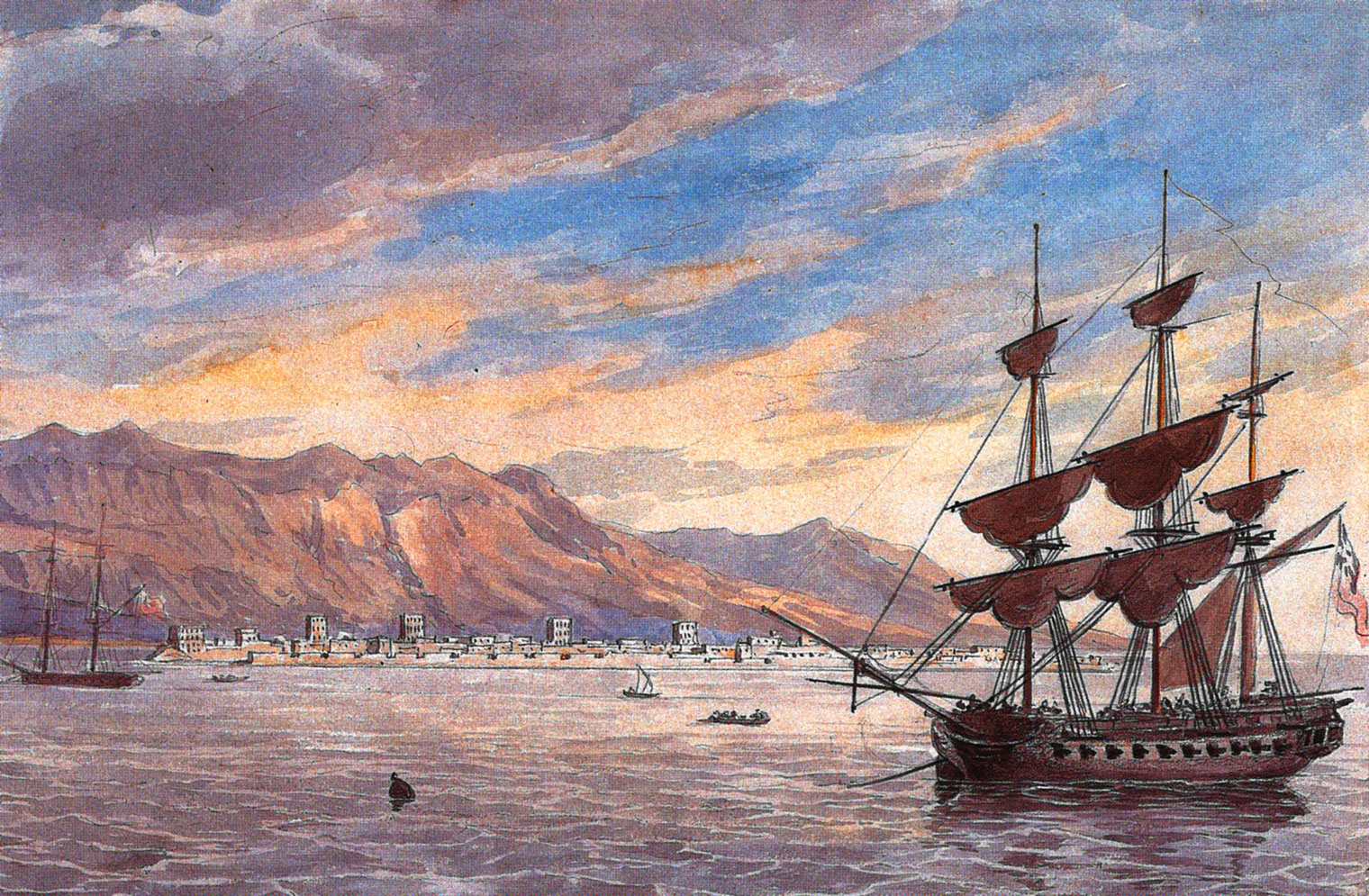
A painting depicting the coast of Ras Al Khaimah in 1809. © Ras Al Khaimah Government Media Office.
By the time Niebuhr visited Ras Al Khaimah during the second half of the eighteenth century, the Qawasim were already a formidable maritime force. Niebuhr was the only survivor of the ill fated Danish Arabia expedition that left Copenhagen in 1761 and wrote extensively of his exploits, beginning with Beschreibung von Arabien in 1772. A condensed English translation of his work – Travels through Arabia and Other Countries in the East – was published in Edinburgh in 1792 and included a description of the Principality of Seer, which “extends from Cape Mussendom along the Persian Gulf”. In that description, Niebuhr noted that: “The Prince of Seer makes some figure among the maritime powers in these parts. His navy is one of the most considerable in the Persian Gulf. His subjects are much employed in navigation and carry on a pretty extensive trade.”
Although trade was their primary concern, throughout much of the eighteenth century the Qawasim were in conflict with either the Omanis, the Persians, or the various tribes that inhabited the islands and shoreline of south-west Persia. These confrontations were centred around Bandar Abbas and the island of Qeshm, but seaborne conflict spread across the entirety of the lower Gulf and the Strait of Hormuz and would prove both costly and lucrative. Sultan bin Muhammad Al-Qasimi, the ruler of Sharjah, has carried out extensive research into the Qawasim, British accusations of piracy, and the power struggles that swept across the Arabian Gulf during the middle part of the eighteenth century. His studies of India Office Records (the archives of the East India Company and the pre-1947 government of India) give a sense of the conflict that raged throughout that period. In June 1760, for example, the Qawasim arrived at Bandar Abbas with an estimated 800 to 1,000 men and a fleet of fifty vessels. On 23 July 1760, they fought an engagement with the forces of Nasir Khan off the coast of Lingeh, leading to Khan’s defeat and eventual retreat. In 1761, a Qawasim fleet consisting of thirty gallivats (small armed boats), dhows and other vessels met a combined Omani and Banu Ma’in force, defeating them near the island of Larak.
Although the Qawasim would suffer occasional reversals of fortune, their prowess as mariners and fighters, merchants and traders, was undoubted. The British author James Silk Buckingham wrote that they “were so much more skilful, industrious, and faithful in their engagements than the other tribes of the coast, that they were always preferred and constantly spoken of as the best people throughout the Gulf.” Lieutenant H. H. Whitelock, who wrote An Account of the Arabs who inhabit the Coast between Ras-el Khaimah and Abothubee in the Gulf of Persia, generally called the Pirate Coast, noted that “they are mostly seafaring people, and at some seasons of the year, particularly during the pearl fishery, the towns are nearly deserted by the men, who leave their wives and children at home under the care of those who have passed the period for active employment in such arduous work.” Printed by the Bombay Geographical Society in 1836, Whitelock’s account also provided an estimate of the number of men and boats involved in pearling. For Ras Al Khaimah, Sharjah and their dependencies, that number was 350 vessels and 3,150 men, although it would have been considerably higher prior to the British attack on Ras Al Khaimah in 1819.
In the early years of the nineteenth century the Qawasim’s strength was assessed by a number of British officers, writers and travellers. In 1816, Buckingham estimated the number of inhabitants in Ras Al Khaimah to be at least 10,000, of which around 3,000 were men capable of bearing arms. Buckingham stated that Sheikh Hassan bin Rahma Al Qasimi’s kinsman, Ameer Ibrahim, was “considered as the commodore of their maritime force. They are thought to have at present about sixty large boats out from their own port, manned with crews of from eighty to three hundred men each. Forty other boats, of a smaller size, may be counted among their auxiliaries, from the ports of Sharjee and Rams on the Arabian coast. Charrack and Linga, on the Persian coast, and Luft, on the inside of the island of Kishma [Qeshm], are subject to their authority. Their force, if concentrated, would thus amount to at least three hundred vessels, with perhaps four hundred pieces of cannon, and about eight thousand fighting men, well armed with muskets, swords, and spears.” These men were described by Buckingham as wearing “large sword[s] of the old Norman form, with long straight blades of great breadth, and large cross handles, perfectly plain; short spears were also borne by some, with circular shields of tough hide, ornamented with knobs of metal and gilding.”
A few years later, in 1819, Captain George Forster Sadlier of the forty-seventh Regiment of Foot spent eleven days in Muscat on a fact-finding mission for the government of Bombay. Part of a much broader mission that he would later recount in Diary of a Journey across Arabia from el Khatif in the Persian Gulf, to Yambo in the Red Sea, during the Year 1819, Sadlier also provided an estimate of the forces available to the Qawasim. These included: twenty-five large boats, seventy-one small vessels, and 3,000 men in Ras Al Khaimah and Jazirat al-Hamra; twelve large boats, 150 smaller ones, and 1,280 men in Sharjah; four large boats, thirty-five small vessels, and 1,000 men in Ajman; one large boat, thirty smaller vessels and 400 men in Umm Al Quwain; as well as 200 men in Rams and between 150 and 200 men in Sha’am.
In 1838 (although referencing past endeavours), Wellsted wrote that the Qawasim would embark “from their ports in the southern part of the Persian Gulf, in large and swift sailing vessels, of from two hundred to four hundred tons, of which it is estimated they had then more than a hundred, and sailing together in large fleets, they kept the whole coast of Arabia, the entrance to the Red Sea, and the northern shores of India, in a state of constant excitement and alarm.” Wellsted, a naval lieutenant aboard the surveying ship Palinurus during the 1830s, noted that “the most undaunted bravery was certainly theirs; if taken, they submitted with resignation to the fate they inflicted on others; and when they fell into the hands of the Persians, or other nations by which they are surrounded, they were never spared… Though often repulsed or defeated, and even in one instance stormed with success in their principal strongholds, yet they never appeared to lose either energy or spirit for any considerable period. New vessels were built or purchased, other forts erected, and after a brief interval they again renewed their outrages.”
The latter part of Wellsted’s quote refers to the accusations of piracy that would plague the Qawasim from 1804 onwards. From that year on, Britain’s perceived threat to its mercantile activities, the increased influence of the Saudis on the internal politics of Ras Al Khaimah, and the spread of the Qawasim’s naval presence to the coast of India would lead to bloody confrontations with the British. Unfortunately, little or no contemporary Arab sources are available, apart from the occasional correspondence received by the British from Qawasim leaders. This would not change until the middle of the nineteenth century, when a period of prosperity and stability would emerge under the leadership of Sheikh Sultan bin Saqr Al Qasimi.
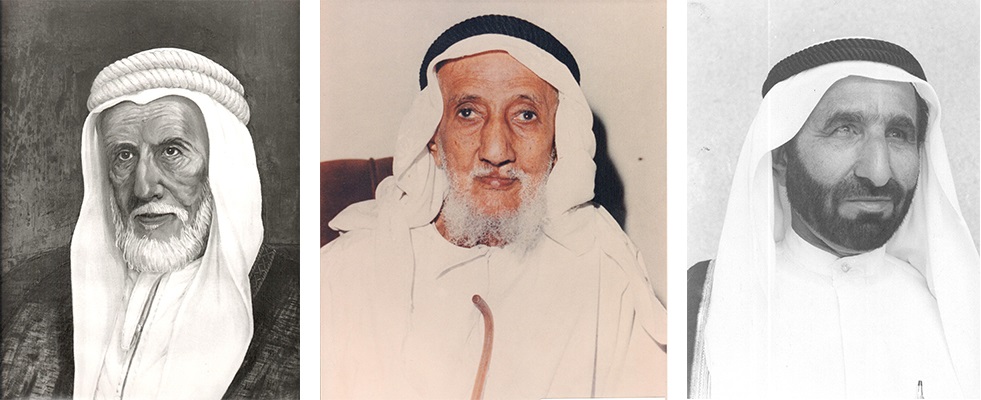
Portraits of Sheikh Salim bin Sultan Al Qasimi; Sheikh Sultan bin Salim Al Qasimi; and Sheikh Saqr bin Mohammed Al Qasimi. © RAK Media Office.
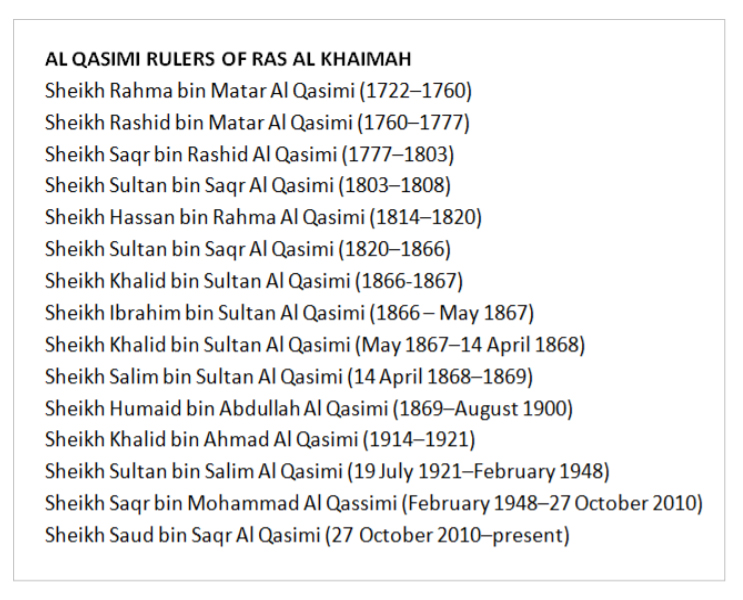
A timeline of the Al Qasimi Rulers.
REFERENCES
Al-Otabi, Mubarak: The Qawasim and British Control of the Arabian Gulf (1989). Read More
Al-Qasimi, Sultan bin Muhammad: Power Struggles and Trade in the Gulf 1620-1820 (1999). Read More
Buckingham, James Silk: Travels in Assyria, Media, and Persia (1829). Read More
Farinha, António Dias: “Arabs and Portuguese in the area of the Emirates and the Arabian Gulf (XVI-XVIII Centuries)” in New Perspectives On Recording UAE History (Abu Dhabi: National Center for Documentation & Research, 2009).
Lorimer, John Gordon: Gazetteer of the Persian Gulf, Oman and Central Arabia (1908). Read More
Low, Charles Rathbone: The Land of the Sun: Sketches of Travel, with Memoranda, Historical and Geographical, of Places of Interest in the East (1870). Read More
Miles, Samuel Barrett: The Countries and Tribes of the Persian Gulf (1919). Read More
Niebuhr, Carsten: Travels Through Arabia and other Countries in the East (1792). Read More
Ruzayq, Hamid ibn Muhammad ibn: A History of the Imams and Seyyids of Oman (1871). Read More
Sadlier, George Forster: Diary of a Journey across Arabia from el Khatif in the Persian Gulf, to Yambo in the Red Sea, during the Year 1819 (1866). Read More
Warden, Francis: Historical sketch of the Joasmee tribe of Arabs, from the year 1747 to the year 1819 (1856). Read More
Wellsted, James Raymond: Travels in Arabia (1838). Read More
Whitelock, H. H.: “An Account of Arabs who Inhabit the Coast between Ras-el-Kheimah and Abothubee in the Gulf of Persia, Generally Called the Pirate Coast,” Transactions of the Bombay Geographical Society 1, 1836-38, pp. 32-54. Read More